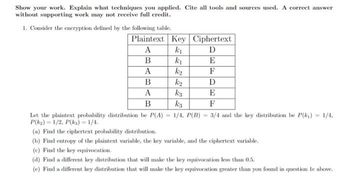
Database System Concepts
7th Edition
ISBN: 9780078022159
Author: Abraham Silberschatz Professor, Henry F. Korth, S. Sudarshan
Publisher: McGraw-Hill Education
expand_more
expand_more
format_list_bulleted
Question

Transcribed Image Text:Show your work. Explain what techniques you applied. Cite all tools and sources used. A correct answer
without supporting work may not receive full credit.
1. Consider the encryption defined by the following table.
Plaintext
A
B
A
B
A
B
Let the plaintext probability distribution be P(A)
P(k₂) = 1/2, P(ks) = 1/4.
(a) Find the ciphertext probability distribution.
Key Ciphertext
D
k₁
k₁
E
k₂
F
k₂
D
k3
E
k3
F
1/4, P(B) = 3/4 and the key distribution be P(k₁) = 1/4,
(b) Find entropy of the plaintext variable, the key variable, and the ciphertext variable.
(e) Find the key equivocation.
(d) Find a different key distribution that will make the key equivocation less than 0.5.
(e) Find a different key distribution that will make the key equivocation greater than you found in question le above.
Expert Solution
This question has been solved!
Explore an expertly crafted, step-by-step solution for a thorough understanding of key concepts.
This is a popular solution
Trending nowThis is a popular solution!
Step by stepSolved in 4 steps

Knowledge Booster
Learn more about
Need a deep-dive on the concept behind this application? Look no further. Learn more about this topic, computer-science and related others by exploring similar questions and additional content below.Similar questions
- Consider the affine cipher f(p) = 3p+4 (mod 26), where p is the plaintext representation of the character under consideration. For example the plaintext of the letter A is 0, B is 1, C is 2, ... Z is 25. Use this cipher to encrypt the letters I, N, G, R (changing the numbers back to letters at the end.arrow_forwardLet k be the encipherment key for a Caesar cipher. The decipherment key is 26 – k.One of the characteristics of a public key cryptosystem is that the encipherment anddecipherment keys are different. Explain why the Caesar cipher is a secret keycryptosystem, not a public key cryptosystem?arrow_forwardLet E'(T,X) be a tweakable block cipher that has already been keyed. Given plaintext P = P1 || P2 || ... || Pn (ie, P is an n-block plaintext). Ci = E'(i, Pi) for i=1..nsum = P1 xor P2 xor ... xor Pntag = E'(0,sum) For simplicity let's say that E'(T,X) = ROTL(X,T+1) (ie, X rotated left T+1 bits. If the block cipher block size is 8 bits and you are encrypting the two byte plaintext 67 89, what ciphertext and tag would be created? Fill in each box as a two-digit hex value. C1____? C2____? tag____?arrow_forward
- If an encryption function er is identical to the decryption function dg, then the key K is said to be an involutory key. (a) Let K = (a, b) be a key in an affine cipher over Z/nZ. Show that K is an involutory key if and only if a- = a (mod n) and b(a+1) = 0 (mod n).arrow_forwardAlice and Bod have decided to use a symmetric encryption algorithm. They have some assumptions about their messages:- Messages only contain capital letters (i.e. A to Z)- The length of their shared key must be greater than or equal to the length of the plaintext- They assign each letter a number as follows: (A,0), (B,1), (C,2), (D,3),…, (Z,25)Their algorithm combines the key and the message using modular addition. The numerical values of corresponding message and key letters are added together, modulo 26. For example, if the plain text is “HELLO” and the key is “SECRET” then the encrypted message is calculated as following:Since the length of the plaintext is 5, we just need the first 5 letters of the key (i.e. “SECRE”), then for each letter, we should add corresponding letters in both the plaintext and the key modulo 26.Plaintext: H (7) E (4) L (11) L (11) O (14)Key: S (18) E (4) C (2) R (17) E(4)Cipher: Z (25) I (8) N(13) C(2) S (18) Write a program in Python, C/C++ or JavaScript to…arrow_forward
arrow_back_ios
arrow_forward_ios
Recommended textbooks for you
 Database System ConceptsComputer ScienceISBN:9780078022159Author:Abraham Silberschatz Professor, Henry F. Korth, S. SudarshanPublisher:McGraw-Hill Education
Database System ConceptsComputer ScienceISBN:9780078022159Author:Abraham Silberschatz Professor, Henry F. Korth, S. SudarshanPublisher:McGraw-Hill Education Starting Out with Python (4th Edition)Computer ScienceISBN:9780134444321Author:Tony GaddisPublisher:PEARSON
Starting Out with Python (4th Edition)Computer ScienceISBN:9780134444321Author:Tony GaddisPublisher:PEARSON Digital Fundamentals (11th Edition)Computer ScienceISBN:9780132737968Author:Thomas L. FloydPublisher:PEARSON
Digital Fundamentals (11th Edition)Computer ScienceISBN:9780132737968Author:Thomas L. FloydPublisher:PEARSON C How to Program (8th Edition)Computer ScienceISBN:9780133976892Author:Paul J. Deitel, Harvey DeitelPublisher:PEARSON
C How to Program (8th Edition)Computer ScienceISBN:9780133976892Author:Paul J. Deitel, Harvey DeitelPublisher:PEARSON Database Systems: Design, Implementation, & Manag...Computer ScienceISBN:9781337627900Author:Carlos Coronel, Steven MorrisPublisher:Cengage Learning
Database Systems: Design, Implementation, & Manag...Computer ScienceISBN:9781337627900Author:Carlos Coronel, Steven MorrisPublisher:Cengage Learning Programmable Logic ControllersComputer ScienceISBN:9780073373843Author:Frank D. PetruzellaPublisher:McGraw-Hill Education
Programmable Logic ControllersComputer ScienceISBN:9780073373843Author:Frank D. PetruzellaPublisher:McGraw-Hill Education

Database System Concepts
Computer Science
ISBN:9780078022159
Author:Abraham Silberschatz Professor, Henry F. Korth, S. Sudarshan
Publisher:McGraw-Hill Education

Starting Out with Python (4th Edition)
Computer Science
ISBN:9780134444321
Author:Tony Gaddis
Publisher:PEARSON

Digital Fundamentals (11th Edition)
Computer Science
ISBN:9780132737968
Author:Thomas L. Floyd
Publisher:PEARSON

C How to Program (8th Edition)
Computer Science
ISBN:9780133976892
Author:Paul J. Deitel, Harvey Deitel
Publisher:PEARSON

Database Systems: Design, Implementation, & Manag...
Computer Science
ISBN:9781337627900
Author:Carlos Coronel, Steven Morris
Publisher:Cengage Learning

Programmable Logic Controllers
Computer Science
ISBN:9780073373843
Author:Frank D. Petruzella
Publisher:McGraw-Hill Education